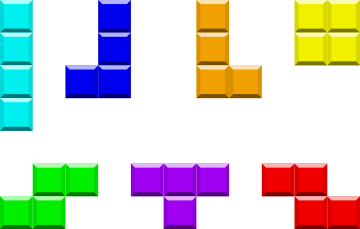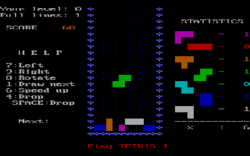The Tetris game is a popular use of tetrominoes, the four element special case of polyominoes. Polyominoes have been used in popular puzzles since at least 1907, and the name is given by the mathematician Solomon W. Golomb in 1953. However, even the enumeration of pentominoes is dated to antiquity.
The game (or one of its many variants) is available for nearly every video game console and computer operating system, as well as on devices such as graphing calculators, mobile phones, portable media players, PDAs, Network music players and even as an Easter egg on non-media products like oscilloscopes. It has even inspired Tetris serving dishes and been played on the sides of various buildings, with the record holder for the world's largest fully functional game of Tetris being an effort by Dutch students in 1995 that lit up all 15 floors of the Electrical Engineering department at Delft University of Technology.
While versions of Tetris were sold for a range of 1980s home computer platforms, it was the hugely successful handheld version for the Game Boy launched in 1989 that established the reputation of the game as one of the most popular ever. Electronic Gaming Monthly's 100th issue had Tetris in first place as "Greatest Game of All Time". In 2007, Tetris came in second place in IGN's "100 Greatest Video Games of All Time". It has sold more than 70 million copies. In January 2010, it was announced that Tetris has sold more than 100 million copies for cell phones alone since 2005.
Gameplay
The seven one-sided tetrominoes in their Tetris Worlds colors. Top row, left to right: I, J, L, O. Bottom row: S, T, Z.
A random sequence of tetrominoes (sometimes called "tetrads" in older versions)—shapes composed of four square blocks each—fall down the playing field (a rectangular vertical shaft, called the "well" or "matrix"). The objective of the game is to manipulate these tetrominoes, by moving each one sideways and rotating it by 90 degree units, with the aim of creating a horizontal line of blocks without gaps. When such a line is created, it disappears, and any block above the deleted line will fall. With every ten lines that are cleared, the game enters a new level. As the game progresses, each level causes the tetrominoes to fall faster, and the game ends when the stack of tetrominoes reaches the top of the playing field and no new tetrominoes are able to enter. In certain versions, the game can also end if the player is able to get all the way to level 15.
All of the tetrominoes are capable of single and double clears. I, J, and L are able to clear triples. Only the I tetromino has the capacity to clear four lines simultaneously, and this is referred to as a "tetris". (This may vary depending on the rotation and compensation rules of each specific Tetris implementation. For instance, in the Super Rotation System used in most recent implementations,[16] called "Easy Spin" in Tetris Worlds, certain rare situations allow T, S and Z to 'snap' into tight spots and clear triples.)
Scoring
The scoring formula for the majority of Tetris products is built on the idea that more difficult line clears should be awarded more points. For example, a single line clear in Tetris Zone is worth 100 points, while a back-to-back Tetris is worth 1,200.
Nearly all Tetris games allow the player to press a button to increase the speed of the current piece's descent, rather than waiting for it to fall. If the player can stop the increased speed before the piece reaches the floor by letting go of the button, this is a "soft drop"; otherwise, it is a "hard drop" (some games allow only soft drop or only hard drop; others have separate buttons). Many games award a number of points based on the height that the piece fell before locking.
Gravity
Traditional versions of Tetris move the stacks of blocks down by a distance exactly equal to the height of the cleared rows below them. Contrary to the laws of gravity, blocks may be left floating above gaps. Implementing a different algorithm that uses a flood fill to segment the playfield into connected regions will make each region fall individually, in parallel, until it touches the region at the bottom of the playfield. This opens up additional "chain-reaction" tactics involving blocks cascading to fill additional lines, which may be awarded as more valuable clears.
History
Screenshot of the 1986 IBM PC version
Tetris has been involved in many legal battles. In June 1984, Alexey Pajitnov created Tetris on an Elektronika 60 while working for the Soviet Academy of Sciences at their Computer Center in Moscow with Dmitry Pavlovsky, and Vadim Gerasimov ported it to the IBM PC. Gerasimov reports that Pajitnov chose the name "Tetris" as "a combination of 'tetramino' and 'tennis'." From there, the PC game exploded into popularity, and began spreading all around Moscow. The most recent version of this port is available on Gerasimov's web site.
The IBM PC version eventually made its way to Budapest, Hungary, where it was ported to various platforms and was "discovered" by a British software house named Andromeda. They attempted to contact Pajitnov to secure the rights for the PC version, but before the deal was firmly settled, they had already sold the rights to Spectrum HoloByte. After failing to settle the deal with Pajitnov, Andromeda attempted to license it from the Hungarian programmers instead.
Meanwhile, before any legal rights were settled, the Spectrum HoloByte IBM PC version of Tetris was released in the United States in 1986. The game's popularity was tremendous, and many players were instantly hooked—it was a software blockbuster, with reviews such as in Computer Gaming World calling the game "deceptively simple and insidiously addictive".
The details of the licensing issues were uncertain by this point, but in 1987 Andromeda managed to obtain copyright licensing for the IBM PC version and any other home computer system.
For Amiga and Atari ST two different versions by Spectrum HoloByte and Mirrorsoft became available. The Mirrorsoft version did not feature any background graphics while the Holobyte version had a background picture related to Russian themes for each level. Games were sold as budget titles due to the game's simplicity. Spectrum's Apple II package actually contained three diskettes with three different versions of the game, for the Apple II+ and Apple IIe on separate DOS 3.3 and ProDOS 5-1/4" diskettes, and for the Apple IIgs on a 3-1/2" diskette, none of which was copy-protected: the included documentation specifically charged the purchaser on his or her honor to not give away or copy the extra diskettes.
By 1988, the Soviet government began to market the rights to Tetris through an organization called Elektronorgtechnica, or "Elorg" for short. Pajitnov had granted his rights to the Soviet Government, via the Computer Center he worked at for ten years.[24] By this time Elorg had still seen no money from Andromeda, and yet Andromeda was licensing and sub-licensing rights that they themselves did not even have.






